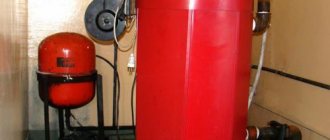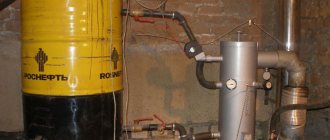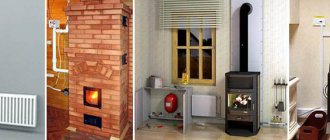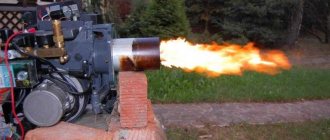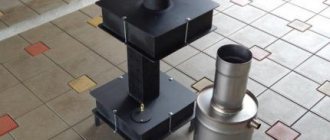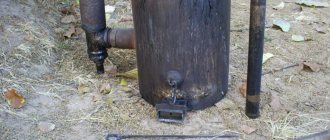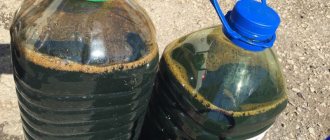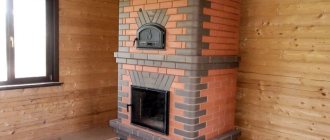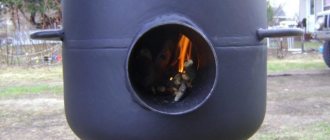How to start and stop a stove
After many experiments, I found the simplest and most effective way to ignite such a stove.
First I pour oil into the pan. There shouldn't be too much of it. It is enough for the oil to cover the bottom of the pan. Then I take a piece of foam rubber and thoroughly moisten it with gasoline or solvent. I place the soaked foam rubber in a tray so that the lower part of the piece is immersed in oil.
Then I set the foam on fire. It burns steadily even when the draft gets too strong. As a result, the surface of the pan is heated to the required temperature.
Then I carefully open the valve of the fuel tank until it begins to flow in a very thin stream. Adjust the feed rate as carefully and slowly as possible
The stove will gradually enter operating mode. Periodically monitor the waste level in the pan.
To stop such a stove, it is enough to simply close the valve on the oil tank, and then, when the oil stops flowing, close the emergency valve. The oven will go out completely within 3-5 minutes and the housing will begin to cool.
Burner device
Pipe with a diameter of 100 mm with a wall thickness of 4 mm and a length of 200 mm (1). Holes with a diameter of 18-20 mm (2) are drilled in the lower part. All burrs on the inside of the pipe are carefully removed. If they are not removed, soot and soot settling on them will narrow the internal diameter of the burner.
The membrane separator is put on the pipe and welded exactly in the middle (3). Then it is installed inside the stove and welded to the inside of the cylinder around the entire perimeter (4). It is advisable to weld a separator at the bottom of the partition; this will create a sufficient height of the side so that in the absence of waste oil it is possible to switch to solid fuel pellets.
What to assemble a stove from
To assemble such a stove, I prepared the following:
- 50 liter gas cylinder;
- steel pipe. It is best to use a pipe with a diameter of 10 cm. Two meters of the product was enough for the body, burner and chimney;
- steel corner. In total, it took me a little more than a meter of 5 cm corner. From it I made a stand for the stove, various internal parts of the heat exchanger and door handles;
- sheet of steel. About 50 cm2 of 4 mm sheet was used for the plugs and the bottom of the upper chamber;
- brake disk. I used a cast iron disk from a machine. The main thing is that it fits freely into the cylinder;
- empty freon bottle. A standard bottle will do. The main thing is that the needle valve works. I used it to make a fuel tank;
- a piece of fuel supply hose;
- a pair of clamps;
- a piece of half-inch pipe. Oil will be supplied to the stove through it;
- half-inch valve;
- loops.
Basic rules of operation and maintenance
To protect yourself when using a homemade stove, and also to extend the life of the structure, you must adhere to some rules:
- it is prohibited to fill the lower compartment with liquid fuel more than 66 percent;
- to ignite, you must first ignite the paper sheet and then lower it into the lower tank;
- the required operating mode is set by adjusting a special damper;
- during operation it is not allowed to use other types of liquid fuel, the design is intended exclusively for testing;
- Do not leave a lit stove unattended for a long period of time;
- Attaching the structure to the walls of the building and using high stands should be avoided;
- It is prohibited to place the oven directly under shelves or other objects that may fall;
- Do not keep flammable substances in close proximity to the heating device;
- the room in which the stove will be operated must have good ventilation;
- Water should not get into the oil, otherwise it will foam and slowly splash out;
- contacting surfaces of the room must be made of non-combustible materials;
- cleaning the internal parts of the structure is allowed in any convenient way;
- There is no need to add fuel after ignition; the poured portion of waste should burn out completely.
You should stick to approximately these sizes
The structure must be cleaned regularly
Operating principle and design of the furnace during mining
The oven operates on the principle of a blowtorch . The furnace structure consists of two tanks connected to each other by an air supply pipe. Used oil is poured into the lower container, in which the upper layer is heated and forms oil vapor. Then the steam rises into the pipe, mixing with air, combustion becomes more active, and upon reaching the upper reservoir, it burns out. Combustion products are discharged through the chimney.
The design of the furnace can be different and changed depending on the material used or to perform additional tasks. It is better to connect furnace parts using arc welding . Using thick steel will make the most sense in order to increase service life. You can use not only steel sheets, but also gas cylinders, as well as other finished steel products such as barrels. Universal furnaces can operate not only on waste, but also on other solid waste. The working stove does not depend on weather and electrical conditions; it can be installed in any locality, country house, greenhouse, garage, auto repair shop.
In the 60s, the Babington burner was developed for heating, which gained wide popularity among dacha owners. Manufacturing technology here:
The principle of operation of boilers during mining
A homemade waste oil boiler can operate according to one of two schemes:
- With the combustion of fuel in one container and its afterburning in the second - a kind of pyrolysis scheme;
- With the ignition of heated and evaporated fuel - an extremely effective scheme.
If you set fire to used oil in any container, it will burn with a yellow, slightly smoky flame. Even if the resulting heat is taken into the heating system, it will not be enough to heat the premises. In addition, in combustion products we will find a bunch of unburned and toxic components. Therefore, the main task of a heating boiler using liquid fuel is to ensure optimal combustion conditions for waste oil. The resulting heat is sent to the water circuit.
The first scheme is used in the simplest ovens, like this one:
Combustion in this scheme is carried out with air intake through the control valve.
Here we see a fuel tank with a control valve, an afterburner and a secondary chamber. Secondary air is supplied to the afterburner through rows of side holes. The used oil is poured into the tank, a little kerosene is poured on top of it, after which it is ignited.
The flame in the afterburner will initially be yellow because the oven is cold. As it warms up, it will acquire a white-pink hue, and a hum will appear, characteristic of a powerful stream of flame. This means that the unit has entered operating mode. By increasing the size of the upper chamber and adding a tubular heat exchanger to it, we get a simple exhaust furnace with a water circuit.
To consider the second scheme of a hot water boiler using waste oil, we will take the following diagram:
Diagram and principle of operation of a hot water boiler using waste oil
This is not exactly what we need, but the principle is the same. The unit shown in the figure includes several important components. The first unit is the fuel tank, which supplies waste oil to the boiler. The supply should be drip. The waste enters a bowl in which a flame is ignited. As the structure warms up, the oil begins to enter the bowl already hot, and its combustion temperature increases.
Combustion takes place in the internal volume of the furnace, limited by a metal cylinder. This is our combustion chamber - air enters it from above, and in the upper side part there is an outlet for the chimney. The presented drawing shows a unit with a blower, which makes its operation more efficient. There is no water jacket here, but there is a blower that blows air over the inner cylinder with the combustion chamber. Hot air can be sent through ducts into heated rooms.
When using air ducts, they must be carefully insulated to reduce heat loss.
A water circuit will help you organize heating using waste oil yourself. To do this, we remove the blower fan and hot air nozzle from the drawing; there will be no holes in their place. Instead, we weld a coil to the cylinder with the combustion chamber, which plays the role of a heat exchanger. It can be made from a pipe of suitable diameter. The ends of the pipe are brought out - the heating circuit is connected to them.
Thus, we have made an excellent waste oil furnace with a water circuit. All that remains is to work on increasing efficiency. To do this, we can wrap the chimney pipe with an additional heat exchanger and connect it to the main one. Now we wrap our hot water heating boiler in thermal insulation, after which we clothe it in an additional casing - this will help reduce heat losses.
Waste oil furnace with water circuit
The external simplicity of the exhaust furnace design is deceptive.
In appearance, these are two blind containers, one on top of one. They are connected by a hollow tube in which air supply holes are drilled. However, complex chemical reactions take place inside.
And it depends on how well the stove is made whether it will puff and heat safely, or will turn into a source of the heaviest compounds, akin to waste from the rocket industry.
Therefore, to make homemade furnaces for mining with a water circuit, you need to take ready-made drawings of the furnace for mining, and not approximate outlines, and strictly adhere to all dimensions.
Used oil is an excellent and inexpensive fuel. Do-it-yourself waste oil stove - pros and cons, do-it-yourself production.
The construction of long-burning wood boilers for the home and the principle of operation will be discussed here.
Buleryan stoves are still popular; they are now produced under the Breneran brand. In this article we will talk about the features of this design and compare its efficiency with gas heating.
Fuel requirements
The fuel can be any used oil: motor, transmission or industrial. The only condition is that it should not contain any impurities. The presence of even minor inclusions can lead to an explosion.
The presence of water in the oil is also unacceptable - it begins to boil much faster than the oil, foaming, splashing and sudden ignition occur. All this can lead to a fire.
The oil must be filtered before filling the tank! Do not use other flammable liquids! Gasoline is used only in small quantities to ignite a cold stove!
Oven for small spaces
One of these solutions was furnaces using waste motor or industrial oil. It can be found in any quantities in car parks, service stations and industrial production. The cost of such raw materials will be minimal or it can be obtained for free.
In terms of its properties and principle of use, used oil is in no way inferior to electric heaters in terms of power. It is necessary to know that used oil for such purposes must first be cleaned of all impurities.
You cannot do this on your own, so you should resort to a purchased version of already purified oil, which in any case will be very inexpensive. In addition, unrefined oil directly affects the safety of the device. It may contain alcohol or water, which will heat up at high temperatures and may cause an explosion and fire.
When using such fuel, it is important to know that it is afraid of cold . If you purchase it in large quantities, you should take care of where it is stored during the winter.
In addition, using a stove using this oil is an excellent economical option for heating small rooms - a utility room, a garage, especially for working in the cold season.
There are several types of heating stoves:
- Waste oil furnaces.
- Waste oil furnaces with a water circuit.
- Stoves and fireplaces.
The last two options can be used for broader purposes, for heating a summer house or a small country house. Their use is especially convenient for two-story buildings. The operating principle of such furnaces is to directly heat air , which goes up, becoming lighter. The inconvenience lies in heating very large rooms of more than 100 square meters - the heat is not distributed efficiently and rather slowly. In car services and private workshops, it is advisable to use exhaust furnaces with a water circuit; there is access to oil in almost unlimited quantities.
Today, the use of such heating devices is growing rapidly. Their production is put on stream, both by private craftsmen who are constantly refining their designs, and by entire factories.
The main advantage that speaks in favor of the use of furnaces is simplicity of design and efficiency, as well as a simple operating principle.
Universal scheme
We unfairly ignored another scheme for building a boiler that runs on waste oil - based on a burner. Here we can use a simple Babington burner, characterized by high efficiency and simple design
It uses a metal ball through which the waste flows. The ball itself has a hole through which air is supplied. It picks up the smallest particles of used oil, spraying it. The finished air-droplet mixture is ignited and forms a steadily burning high-temperature flame.
The finished burner is connected to a universal factory boiler that can work with any type of burner. It is also mounted in conventional solid fuel metal and brick stoves. Advantages of the resulting assembly:
- You can regulate the temperature by limiting the fuel supply to the waste oil burner.
- Possibility of automating combustion intensity adjustment.
- Possibility of switching to another type of fuel - for example, pellets, natural or liquefied gas.
By choosing a Babington burner to build a homemade boiler, consumers have at their disposal a device that can operate even on contaminated waste oil. The main task is to provide air supply under high pressure. Typically, compressors from refrigerators are used for this.
As a basis for homemade work, we select a drawing of any heating boiler with a traditional wood burning scheme. A small illustration will help you understand the essence:
Here we see a boiler that can work with equal success both on wood and waste oil - with the help of an appropriate burner.
The work takes place in several stages. The first is to assemble a Babington burner according to this scheme (or any other):
There are a great variety of Babington burner assembly schemes. We decided to use the most common one here.
The second stage is the assembly of a suitable solid fuel stove, which will subsequently operate on waste oil. When choosing a drawing and following it, do not under any circumstances reduce the size of the combustion chamber where the burner flame escapes - if tomorrow you do not have enough work, you will have to freeze. And you can always throw a portion of firewood into the large combustion chamber and continue to enjoy the warmth.
The third stage is connecting individual elements. The burner is connected to the fuel tank, after which it is inserted into the boiler assembled by yourself. We start heating the oil in the tank, open the valve, turn on the compressor, ignite the fuel-air mixture, and control the operation of the water circuit.
If necessary, you can switch from used oil to liquefied gas. To do this, purchase a gas burner (no homemade products with gas!) and install it instead of a liquid burner. A gas cylinder is connected to it. As a result, you will get full-fledged water heating, albeit somewhat voracious.
Varieties of homemade stoves
There are units on sale, the cost of which can reach up to 100 thousand rubles. Such models have a guarantee, an aesthetic appearance, are painted with heat-resistant paint, and have a built-in fan for ventilation.
Fuel is supplied by the drip method, which reduces its costs and increases efficiency. The ignition function is automatic. But you don’t always want to spend that kind of money to heat your garage. It’s easy to make a furnace using waste oil yourself if you have minimal experience working with a welding machine.
Improved oven
Modified models have plugs for draining condensate so that it does not fall back into the oven. The same containers are installed on the chimney - they collect liquid that is formed when cold and warm air come into contact (the principle of a moonshine still). There is a fan that cools the bottom of the stove so it doesn't overheat. Another fan forces air into the inlet to enhance combustion - a supercharged model. To supply fuel, craftsmen install ordinary pumps bought in a store.
Gas cylinder stove
An old gas cylinder is used as a chamber for filling fuel . The cylinder is made of thick steel, which ensures long-term use. It has suitable dimensions: the area that can be heated by such a unit is up to 85 square meters.
The top part is cut off and a handle is welded to it.
It is advisable to use asbestos as a gasket to prevent gases from entering the room.
To ensure stability, the legs are welded. The function of the heat exchanger is performed by a cylinder of similar size, hand-welded from steel with a thickness of at least 5 mm. Next you need to install a chimney. For this, a pipe with a diameter of 10–12 cm is useful.
It is welded horizontally into the heat exchanger and pulled 5 meters through the room under the ceiling . They are taken out the window and then directed upward. For pipe bends, you need to use short pieces and weld them at an angle to create an elbow.
Stove with water circuit
You can make a furnace using waste oil with your own hands with a water circuit . This will increase the heat transfer time by heating the water. Warm water can be used for technical purposes. The principle of the device: a metal water barrel is installed around the heat exchanger pipe. It has a hole for water inlet and outlet.
An exhaust furnace with a water circuit can be made from the same gas cylinder. Only in the middle will it be necessary to insert a container for filling fuel with a pipe connected to the heat exchanger. The pipe in this case will be longer than with a conventional design. This design will occupy the lower part of the cylinder. The upper part of the cylinder must be sealed and filled with water. To fill with water, use a copper pipe on which a circulation pump is installed - the lowest-power and cheapest will do.
Attention! If you need a pressurized furnace for a garage, then you need to place a fan and connect it to the network. A waste oil furnace with an installed fan burns fuel much more efficiently, so for one volume of fuel the efficiency increases by 30%.
Sheet metal oven
The simplest design can be welded from metal. To do this, you will need steel sheets 4–6 mm thick so that the furnace will serve for a long time.
Stages of work:
- Cut square blanks for two containers - 4 pieces in total.
- Cut out the side parts - the same size rectangular shape.
- Weld the boxes.
- Cut out parts for the transition pipe, make holes with a drill for air circulation.
- Weld a square pipe.
- Connect both containers, weld the legs from the metal corners to the bottom. Make a filler hole with a flap. A handle can be welded onto the damper for convenience.
- Weld a piece of pipe into the upper container to connect the chimney.
The design of a waste oil furnace is simple, but welding skills are required so as not to burn through the metal , which can subsequently affect the life of the unit.
To make the process of assembling the stove more clear, it is recommended to first make preliminary drawings with dimensions and then get to work. You can see how to make a stove at work with your own hands in the videos.
Do-it-yourself waste oil stove from a pipe
The easiest way to make a furnace body is from a gas or oxygen cylinder, pipe or barrel with thick walls (read: “How to make an exhaust furnace from a gas cylinder - theory and practice”). Such a unit will be able to produce a maximum of 15 kW of heat. It will not be possible to exceed this threshold, since due to a violation of the thermal regime the boiler will begin to smoke, and this is quite dangerous.
First we need to create a body - this is done in the following sequence:
- We take a pipe with a cross-section of 21 cm, a wall thickness of 1 cm and a height of 78 cm.
- To make the bottom, we take sheet steel with a thickness of more than 0.5 cm. After cutting out the bottom with a diameter of 21.9 cm, we weld it on one side.
- Next, legs are welded to the bottom, which can be made from bolts.
- Now you need to make a viewing window, which is located at a distance of 8 cm from the bottom. It is necessary to monitor the combustion of the bowl at the start. The size of the window is determined based on personal preference. The door is made from a cut piece of pipe to which a thin collar is welded. To ensure that the door closes hermetically, an asbestos cord is laid around its perimeter.
- A smoke exhaust pipe with a cross-section of 10.8 cm and walls 0.4 cm thick is welded on the opposite side of the body, 7-10 cm from the top.
Making the lid:
- Take a piece of metal 0.5 cm thick and cut out a circle with a diameter of 22.8 cm from it.
- We weld a collar of 3 mm metal 4 cm high along the edge of the circle.
- In the center of the lid we make a hole with a cross-section of 8.9 cm, and on the side we cut a hole with a diameter of 1.8 cm. The second hole is necessary to obtain an additional viewing window. It requires a lid, which is also a safety valve.
Now, for a pressurized exhaust furnace, it is necessary to make a pipe for transporting air and fuel:
- You will need a pipe with a cross-section of 8.9 cm, a wall thickness of 0.3 cm and a length of 76 cm.
- We drill 9 holes around the circumference, with a distance of 5 cm from the edge, and their diameter should be 0.5 cm.
- Stepping back 5 cm, we make two more rows, 8 pieces each, of holes with a cross-section of 0.42 mm.
- After another 5 cm, 9 holes are drilled in the fourth row with a cross section of 0.3 cm.
- On the same side, 9 slits are made along the edge, 0.16 cm thick and 3 cm high. To do this, you can use a grinder.
- From the opposite end of the pipe, moving 0.5-0.7 cm from the edge, make a hole with a cross-section of 1 cm.
- We insert the fuel supply pipe into the prepared hole. The thickness of its wall should be 0.1 cm, and the cross-section should be 1 cm. It should be at the same level as the air supply pipe. Its bend and length are determined by the location of the fuel container.
- The air and fuel supply pipe is welded to the cover. It must be positioned in such a way that there is 12 cm left from it to the base of the body.
It's time for the supercharged stove to make a bowl for fuel:
- First, take a pipe with a cross-section of 13.3 cm and a wall thickness of 0.4 cm, cut a piece 3 cm long.
- Now we cut out a circle with a diameter of 21.9 cm from 2 mm sheet steel.
- By welding it to a piece of pipe, we get a bowl into which we will supply fuel.
Let's start assembling a garage stove for testing:
- We retreat 7 cm from the bottom of the body and mount the bowl inside it.
- We mount the cover together with the fuel supply device.
- We install the chimney on the smoke pipe. The chimney must be positioned strictly vertically; even slight slopes are prohibited. The part of the pipe that remains indoors does not need to be insulated, but the part that goes outside is better insulated.
After the oil nozzle for the stove and the oil block are installed, testing proceeds. First, a certain amount of paper is placed in the bowl, a flammable liquid is added and set on fire. The oil supply begins after the paper has almost burned out.
Taking into account fuel consumption of 1-1.5 liters per hour, it will be possible to heat up to 150 square meters of space.
How to make a waste oil stove: step-by-step instructions
The most common furnace model used for mining is made from pipe sections with a diameter of 352 mm and steel sheets 4 mm and 6 mm thick. You need to prepare a small piece of thick-walled pipe with a diameter of 100 mm and a metal steel corner for supports. This model can cope with heating an area of 80 square meters. meters.
Tools you will need for work:
- welding equipment;
- grinder with a circle for cutting metals and a grinding disc;
- drill;
- roulette.
You also need to purchase heat-resistant paint and solvent.
Stages of manufacturing a stove for mining with a water circuit according to the drawings:
- The necessary parts are cut out, and burrs are removed from the cut areas;
- The lower tank is welded from a pipe 115 mm high and 344 mm in diameter. The bottom is made of steel sheet. The legs can be welded from a metal corner or from pipe scraps.
- A pipe section with a diameter of 100 mm and a height of 360 mm is perforated.
- The lid of the lower tank is assembled together by welding: a pipe with a diameter of 352 mm, a height of 60 mm, a lid with two holes and a perforated pipe. The damper is secured to the air supply hole with rivets.
- Parts of the upper compartment are welded from a pipe with a diameter of 352 mm and a height of 100 mm. The bottom is welded from a steel sheet, in which there is a hole for a perforated pipe.
- Weld a chimney pipe with a diameter of 100 mm and a height of 130 mm. On the inside of the lid, closer to the chimney, a partition made of steel sheet is attached.
- The upper chamber is welded to the lid on which the chimney is installed. The upper chamber is connected to a perforated pipe. You can strengthen the structure by tightening it with an iron rod.
- The upper compartment of the boiler is tightly placed on the lower one.
- In order to increase the service life of the unit, it is painted with heat-resistant silicone paint. Before applying paint, the metal is cleaned of rust, and the seams after welding are cleaned of scale.
- Install the stove and connect it to the chimney duct.
Important. The chimney pipe of a welded stove for mining with a water circuit must be straight, at least four meters long and without bends.
Using the same principle, you can make a rectangular oven.
Do-it-yourself stove: drawings, videos and other useful information
Although many specialized stores have a used stove, not all consumers want to buy it. Many of them are trying to find a more economical solution, which consists of constructing the structure themselves. It is assembled from inexpensive elements.
Massive design on metal legs
As a basis for a future design, you can take an unnecessary gas cylinder. Its walls are quite thick, so it will take a very long time to burn through. In addition, such a container has a suitable shape. Additional materials you will need are metal pipes, corners and sheets.
Drawings for self-production
The internal space must be divided into two combustion chambers. One will be at the bottom and the other at the top. On the bottom side, legs made of metal corners are attached by welding. A partition is attached to the lid of the upper chamber in the same way. It should be located closer to the chimney.
Two circles are cut out of a steel sheet. The first of them will act as a removable cover for the lower chamber. The second circle will create the bottom of the upper compartment. Holes are made in the blanks in the center corresponding to the diameter of the chimney.
48 holes are drilled in the connecting pipe, eight of them are made in a circle, and six are made in height. Their diameter should be 9 mm. This is necessary for the afterburning chamber, in which the burning vapors will be saturated with oxygen. At the final stage, a chimney pipe is connected to the structure.
Special holes must be made in the pipe
In the finished drawings of a waste oil stove you can find specific dimensions of certain parts. If they are not indicated, then you need to make your own measurements.
Creating a waste oil furnace with a water circuit from metal sheets
Above we talked about the design of a structure made from a finished container in the form of a gas cylinder. However, many want to learn how to make a waste stove from ordinary sheets of metal directly with a water circuit. The steel thickness for the walls should be 4 mm, and for the lids and bottom - 6 mm.
Stationary heating structure made of steel sheets
Blanks are cut out from individual sheets according to the drawings. They are cut out using a grinder, and then welded to each other around the perimeter. After manufacturing, the seams are necessarily checked for leaks. A 6x6 mm hole is made in the lid of the lower compartment for filling fuel.
The sheets used must be of sufficient thickness
Holes are drilled in the connecting pipeline, as is the case with a gas cylinder structure. The chimney is attached to the top cover.
Additional drawing for manufacturing the structure
Types of models
Mining furnaces can be made of any shape and design.
The work uses steel sheets, scraps of metal pipes, empty oxygen cylinders, and the necessary tools include a grinder, a grinding and welding machine, and pliers.
There are several models of units with a water circuit:
- round stove made from a cylinder;
- metal pipe structure;
- from welded steel sheets;
- with a profiled pipe as a base.
In this video you will learn about a waste oil furnace with a water circuit:
A common option is a pipe device. It is necessary to prepare two parts with diameters of 35 and 10 cm. The resulting stove will be able to heat a room of up to 80 square meters.
First, all the parts are cut out and prepared: an element from a smaller pipe 36 cm long, 48 round holes are made in it with a drill. Then a container for oil with a height of 11 cm is cut out from a larger workpiece; the second part, 6 cm long, should fit tightly into the first. The length of the third element is 10 cm. A lid with a hole for the chimney, a bottom and a valve with a central opening for the fuel tank, and a damper for oxygen supply are made of steel. A partition is also prepared from steel and welded to the top cover. Four legs are cut out from the corners.
The cut points of all elements are cleaned. The body is welded from a pipe, bottom and legs. Connect the parts of the lower tank cover and attach the damper to it. It is necessary to fasten all the components of the upper chamber, and weld the chimney pipe to its valve. A partition is connected closer to the hole. The upper tank is welded to the body and tightly placed on the lower one. All seams are rubbed down, treated with sealant, and the entire structure is coated with an anti-corrosion compound and organic paint. The finished stove is connected to the chimney, its second end is brought outside the room.
The circuit is welded to the surface of the furnace or a separate container is made for it. The tank can be of any size; it is tightly connected to the chimney and the upper chamber of the stove. You need to make two openings in the wall for hot and cooled water. At the outlet, you need to attach a pressure gauge and thermometer, and install an expansion tank and a circular pump nearby.
What are the requirements for waste furnaces?
Operation diagram
The heating device must be located on an absolutely flat horizontal surface so that the oil level in the lower reservoir is at an equal distance relative to the top of its sides.
The components of such a heater must be made of heat-resistant and high-quality materials. At the very beginning, the slope of the chimney must be made at an angle of 30 degrees, after which it must be given a strictly vertical position and taken out of the heated room. To make a chimney, steel with a thickness of at least 3 mm is required, and only its outer part can be made of galvanized sheet metal or asbestos-cement pipe. The diameter of the smoke exhaust structure or its internal cross-section should not be less than 10 cm in diameter.
The design of the lower tank must be equipped with a valve that can be easily rotated. This will allow you to regulate the power of the stove and control oil consumption. The thickness of the walls of the tank into which the waste is poured should not be less than 3 mm.
The holes in the connecting pipe, like the pipe itself, can have different sizes, but they must be proportional. The diameter of the holes should be equal to 1/10 of the diameter of the pipe itself.
We make a furnace with our own hands at work
There are several simple rules and tips, following which will help you assemble an effective and safe device:
- The stove must stand confidently in the designated place without any tilting or swaying, that is, it must be stable.
- The dimensions, quantity and design of all components must strictly comply with the drawing. Otherwise, it will be difficult to ensure uninterrupted operation of the device.
- Tightness. No combustion elements should fall out of the structure.
When choosing materials for manufacturing, preference is most often given to used gas cylinders. Their thickness and dimensions make it possible to make tanks according to any drawings. In addition, the service life will last more than one year. The product does not require special care . It is necessary to close the chimney, drain the fuel and clear the tanks of debris. This must be done during long periods when the oven is not in use.
The top heating element can also be used as a hotplate for cooking or heating water. A universal product and a very economical and convenient heating option.
Supercharged furnace design
A pressurized homemade stove for testing is a closed cylindrical vessel, inside of which there is a well-known afterburning chamber in the form of a pipe with holes. At the bottom of the vessel there is a door for access to the firebox and ignition. The chimney pipe is welded to the top of the cylinder, and forced air is supplied into a pipe with holes through the top cover or a simple insert through the side wall.
Used oil is located at the very bottom of the vessel and is supplied automatically as needed. The supply methods can be different: from a container with a submersible pump or through a float mechanism, whichever you prefer. The figure above shows a diagram of a stove with air injection, a water jacket and fuel supply using a float valve.
The used oil at the bottom of the container is ignited by adding a small amount of gasoline or solvent, then the blower fan is turned on. After warming up, the fuel begins to actively release vapors that are burned with excess oxygen. As a result, a powerful flame is formed, spreading in all directions, as can be seen in the photo.
The combustion products leaving the furnace body have a very high temperature (sometimes up to 400 ºС), as in the previous case. In order to prevent the release of heat and increase the efficiency of the unit, the chimney must be equipped with a water heat exchanger connected to the heating system through a storage tank. Then you can achieve a furnace efficiency of about 80-85%.
Characteristics of an exhaust furnace with a water circuit
The device consists of two round or square tanks, which are connected to each other by a piece of pipe into which air is supplied and comes out warm through special holes. The waste is poured into the lower part, where it is heated, which creates oil vapor . Mixing with air, the steam burns with greater force and enters the upper part of the furnace.
Furnaces with a water circuit do not have “extra” parts. Their service life is very durable, since breakdowns practically do not occur with simple elements. Convenience lies in the possibility of its operation even at sub-zero room temperatures. Water must be in the heating system constantly.
For even greater convenience when heating a large room, a water circuit is added to the waste oil furnace. The water heats up and, together with the steam from the fuel, rises, cold water comes in its place and the process is repeated. Using a pump, you can connect the stove with batteries, this will ensure almost complete heating of the room as a whole at the lowest cost.
If you are heating a dacha, in which you plan to live only until the winter, so that the coolant does not freeze in the cold due to its downtime, and works even when it is rarely used, it is recommended to add special additives to the water. Most often this is the addition of antifreeze. In a house with permanent residence, it is recommended to use double-circuit stoves. This makes it possible to use additional water for the household needs of the owners.
Advantages
In general, the main advantages can be identified:
- Simplicity of structure.
- Ability to use any spent fuel.
- A relatively cheap product if you buy it ready-made.
- Variety of uses - from garage to country house.
- Mobility of the structure.
- Safety.
- Quite fast heating and long cooling.
- No combustion waste.
- Easy installation.
- Possibility of self-assembly of the structure at home.
The last factor is one of the fundamental ones when choosing a stove. It is not always possible to purchase a separate stove for a summer house or garage.
Oven burner
In conclusion, let us recall one more method of fairly effective drip combustion of waste. This is a water-oil burner. These were once widely used by builders and road workers to heat up bitumen boilers, but now they have practically fallen out of use because the water-oil burner itself is bad: it is gluttonous and produces a lot of smoke. However, if it is attached to the combustion door of any furnace (air enters through the ash pan), then the oil vapor will burn out perfectly in the hot combustion chamber and the water-oil drip furnace will show very good efficiency.
The design of a water-oil burner is simple: fuel and water are dripped simultaneously into a hot bowl over which there is an air flow. Drops of water explode like on a hot frying pan and spray oil into the mist. Fuel vapor flows through the socket through the air flow (furnace draft or pressurization) into the furnace firebox, where it burns. The difficulty in this case is the need to configure 2 drops, fuel and water, but the design of a water-oil burner is simpler than any of the stoves described above, except for the wick. But its efficiency in combination with a potbelly stove is no worse than that of stoves with a flame bowl. How to make a water-oil burner for a stove with your own hands, see the final video:
Below you can share your thoughts and results with our readers and regular visitors.
You can also ask questions to the author*, he will try to answer them.
How does a used oil unit work?
Before you start making your own equipment. We advise you to familiarize yourself with the operating principle of this oven. Of course, you can watch the video, but there you will not find the answer to many of the questions that you will have during the process.
The beauty of this design is its simplicity; at first glance, few people can believe that this small unit is capable of producing such an amount of heat that is enough to heat a relatively large room. In fact, it has been proven that using pressurization and airflow (these systems serve to increase efficiency) it is possible to heat at least
Case manufacturing
I will make a stove from this cylinder.
I used a used cylinder. There was no more gas in it, but just in case, I opened the valve and left the cylinder outside overnight.
Then I carefully and slowly drilled a hole into the bottom of the cylinder. To prevent sparks from appearing, I pre-moistened the drill with oil
Hole
Then I filled the bottle with water and drained it - this removed the remaining gas. Work carefully, try not to spill gas condensate, as... It stinks very strongly and for a very long time.
Then I cut out a couple of openings. In the upper opening I will make a combustion chamber and install a heat exchanger, in the lower opening there will be a burner with a tray. The chamber at the top is specially made so large that, if necessary, it can be heated with wood, pressed briquettes, etc.
Shown how to cut a balloon
Shown how to cut a balloon
Shown how to cut a balloon
Shown how to cut a balloon
In the end this is what happened
Then I once again washed the opened gas cylinder from gas condensate.
Making a drip potbelly stove from a cylinder
To make a furnace from a waste gas cylinder, you need to use a propane cylinder with a wall thickness no thicker than 5 mm. Oxygen cannot be used - firstly, it is too heavy, and secondly, it can explode during the cutting process.
- Unscrew the valve.
- Fill the balloon with water and cut off the top using a grinder.
- Make holes in the body: one for the chimney, the other in the lid for installing an afterburner. At the bottom of the cylinder, for ease of use, you can make an inspection opening, closed with a lid for a bolted connection.
- Make a pipe for the afterburner element by making the necessary holes and grooves in the appropriate places.
- Make a metal bowl and place it on the bottom of the stove.
- Install the afterburner, install the oil line (its end should be located above the bowl), and put on the cylinder cap.
- Make a tank where the fuel will be poured and hang it on the wall closest to the stove.
- Connect the chimney and light the stove.
As you can see in the video “how to make a furnace for mining”, to create an apparatus with a water circuit, you need to attach a stainless steel coil inside the unit (from above), and bring its ends out through the holes in the walls.
In the future, they must be connected to the water heating battery in the utility room.
Fuel supply system
We insert a ½ inch water pipe (1) (with a reserve) into the hole at an angle (30 - 40o), weld it to the stove body. The location of drilling the hole does not play a special role, since the evaporator bowl is made mobile and can be turned with the receiving hole in any direction.
We lower the coupling onto the end of the pipe and mark the outreach distance (2), cut it with a grinder, forming a “spout” for more convenient formation of a stream of oil (3).
A regular water ball valve (4) is screwed to the tube, which will be used as an emergency backup to shut off the fuel supply in the event of a failure of the valve on the exhaust tank.
Work specifics
The hot water boiler is located at the top of the stove. It is non-removable and has taps for drawing water into the bathhouse and for starting the heating circuit. The steam room is heated from a brick wall facing inside. To maximize its effect, it is necessary to make the distance from the stove to the brick box quite small to reduce heat loss, but also sufficient for air penetration. Essentially, you need to build a structure reminiscent of a long-burning brick furnace with your own hands, only the combustion chamber is replaced by a metal furnace during mining. In this case, the creation of a powerful separate foundation will not be required, which greatly facilitates the process of building a bathhouse.
There is another option for making a structure using mining, combined with a brick kiln. Only the lower reservoir is manufactured. The combustion chamber has the shape of an elbow, smoothly bent at 90°. A vertical plate is welded to the end, which communicates with the internal (furnace) part of a conventional brick oven. The hot gases generated during the combustion of waste enter the brick stove and heat it.
The further design is no different from the usual one: a water boiler is installed, a heating circuit with natural or forced circulation, shut-off valves, and so on are connected. This compact option is optimal for those who already have a ready-made furnace and only want to adapt it for burning waste.
Brick stoves with a ready-made water circuit are more stable heat sources that maintain temperature for a long time, which is important when winter cold sets in.
Advantages and disadvantages of a potbelly stove
The exhaust furnace has the following positive characteristics:
- easy to use;
- cheap - oil consumption per hour is up to 1.5 liters ;
- safe, since only waste vapors burn;
- no smell.
Negative points of work:
- oil freezes in cold weather - you need to find a warm place for storage;
- the length of the chimney must be at least 4 meters , which creates difficulties during installation;
- You need to clean the chimney once a week;
- it is necessary to pre-clean the waste from water.
To install the structure, you need to either buy it or assemble a potbelly stove with your own hands. To do this, you need to know what types are on sale and which ones you can make yourself.
Making a pallet for mining
The tray was made from a cast iron automobile brake disc. Cast iron has good heat resistance, so I decided to use it.
I will make a pallet from this disk
I welded the bottom underneath.
The steel circle is the bottom
Welded the bottom
I welded the lid on top. In it you can see the counterpart of the burner and the opening. Air enters the stove through the opening. I made it wide - it's better that way. With a narrow opening, the air draft may not be strong enough, which is why the oil will not be able to get into the pan.
Next I made a coupling. In my stove it connects the pan and the burner. With a coupling it will be much easier to maintain the stove. If necessary, I can take out the tray and clean the burner from below.
Next I made a coupling
coupling
I put the clutch in place
I put the clutch in place
The coupling was made from a 10-centimeter pipe, simply cutting it along the longitudinal edge. I did not weld the opening in the coupling - there is no need for this.
How homemade oil furnaces work
If you burn any used oil, it will smoke strongly and smell unpleasant. In this regard, direct combustion is not used. First, the volatile elements are evaporated and then burned. This approach forms the basis for the operation of a furnace of this design.
There are oil furnaces with two combustion chambers. The lower chamber is designed to heat the fuel and then evaporate it. Combustible vapors are directed upward, saturated with oxygen as they pass through a pipe with holes. Once in the upper part of the pipe, the mixture ignites, and its combustion occurs in the second chamber. This releases more heat with less smoke.
The second method of splitting heavy fuel into easily flammable components is more efficient, but also more difficult to implement. To obtain the required evaporation efficiency, a metal bowl is mounted in the lower chamber. After it heats up, the waste oil evaporates.
Do-it-yourself waste oil furnaces
The stove can be constructed either from cut pipes of various diameters or from sheets of iron. When creating a furnace, you need inventory and material. Such as: an angle grinder, a welding machine, sheets of iron or a used gas cylinder, paint for iron, metal corners. To make heating from metal sheets, you must have welding skills. You will have to weld two chambers for fuel, weld legs to the bottom, connect the two chambers using a pipe with a hole, then install a pipe for the smoke to escape. To use a stove from a cylinder, this method is simpler since the walls are already ready; before starting work, you need to check that the cylinder is empty or release the remaining gas. Then water is poured into the hole and, using a grinder, the upper part is separated together with the hemisphere. Next, the lower part of the balloon is cut off using a similar method. Only after all the above manipulations can you turn to cutting; in a different scenario, the cylinder with the remaining gas will detonate and cause injury.
Depending on which stove you choose from sheets of iron or from a cylinder, you need to know some rules:
- The air from the stove must come out evenly; this rule can be fulfilled by installing a damper, regulating the draft through it.
- The oven should be disassembled for easier cleaning.
- The smoke outlet pipe must be made in a vertical position.
- For the level of traction, the pipe must be made long from 500cm.
Under development: sketches and drawings
Exhaust stoves can be made of any shape and size. As a rule, to make them yourself, you use sheet metal, pipe scraps, or used oxygen cylinders. Several sketches with explanations are given below, and here you can learn how to make a burner from a blowtorch.
Round Sheet Metal Oven
It consists of a fuel tank combined with a combustion chamber, an afterburning chamber - a perforated pipe and an upper chamber equipped with a partition for cutting the flame. On the cover of the lower chamber there is a hole for filling fuel and supplying air. The more the damper is open, the more intense the combustion will be.
From a metal pipe with a water circuit
Consists of two barrels.
At the bottom there is an oil container with a filler hole. The upper combustion chamber is a pipe passing through the upper barrel filled with water. The upper barrel must be equipped with fittings for water supply. The design of such a stove resembles a samovar; its walls do not heat up to excessively high temperatures. Therefore, its installation is recommended for greenhouses, buildings for keeping animals and rooms with small dimensions, where accidental contact and burns from a hot stove are possible. The large dimensions of the tank allow you to create the effect of a heat accumulator.
From profiled pipe
To make a stove with your own hands, use a profiled square pipe of 180x180 mm and 100x100 mm. It is compact in size and easy to manufacture. The surface of the oven can be used as a cooking surface.
Features of furnaces during mining
Processing furnaces are often used to heat garages and car repair shops, hangars, warehouses - those premises where there is an abundance of used technical oil. Problems often arise with its disposal: pouring it into the sewer or into the ground is strictly prohibited. Using oil as fuel is a great solution.
An oil stove works like a potbelly stove: it quickly heats up to a high temperature and heats the air, but when the combustion stops it cools down just as quickly. The entire room is heated only by circulating heated air, so it is difficult to heat a large garage or workshop with such a stove. This problem can be solved by equipping it with a water circuit and connecting heating radiators.
